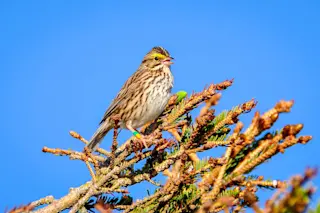A Savannah Sparrow at Bowdoin Scientific Station on Kent Island, New Brunswick Canada, subject of a playback experiment that revealed wild birds learn to sing based on sounds they hear in the first year of their life. (Credit: Dan Mennill) Researchers have taught a population of wild sparrows to sing a different song. Out today in Current Biology, the research suggests new answers to the question of how birds learn to sing. “This was a risky experiment we conducted because we didn’t know if it was going to work,” says Dan Mennill, lead author of the study. Mennill explains that song learning has been studied for years in controlled laboratory settings. But it’s much more difficult to run an experiment in the wild since there are so many complex factors at play. The team, led by Mennill at the University of Windsor, was interested in learning about how – and ...
Wild Sparrows Learn Experimental Songs
Discover how birds learn to sing in the wild! This study reveals insights into Savannah Sparrow song learning and teaching methods.
More on Discover
Stay Curious
SubscribeTo The Magazine
Save up to 40% off the cover price when you subscribe to Discover magazine.
Subscribe













